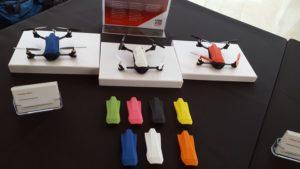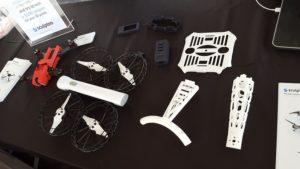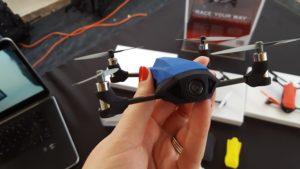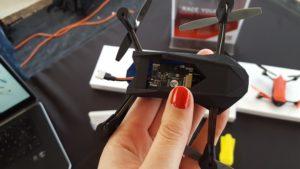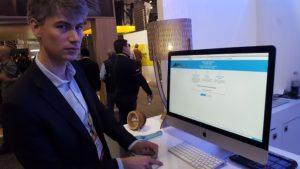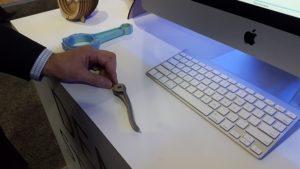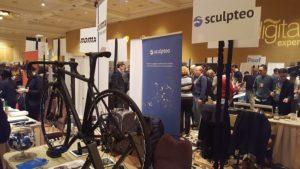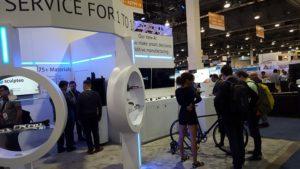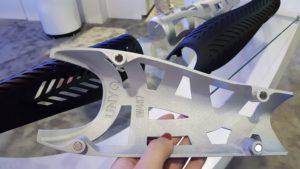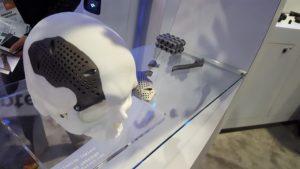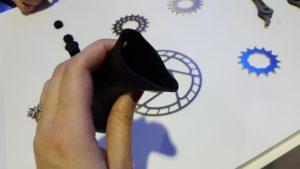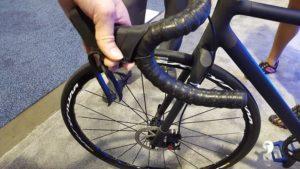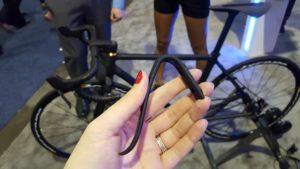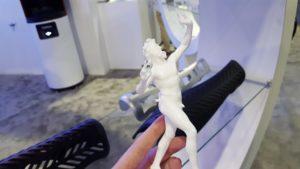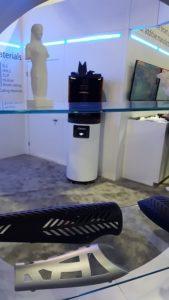 The guy I had a crush on my freshman year of college seemed to be everywhere I went on campus. I’d see him daily in the dining hall, at parties, on the way to classes in adjacent buildings, sitting outside on the steps of the dorm. This was not the worst situation to be in by any stretch, as it gave me ample opportunity to try to catch his eye. While things didn’t ever really go anywhere with that guy (his loss), I had that same feeling again at CES last week in Las Vegas. On my freshman and sophomore days in town (carrying the analogy too far?), it felt like everywhere I went I ran into Sculpteo. And this French company is clearly one that turns heads.
The guy I had a crush on my freshman year of college seemed to be everywhere I went on campus. I’d see him daily in the dining hall, at parties, on the way to classes in adjacent buildings, sitting outside on the steps of the dorm. This was not the worst situation to be in by any stretch, as it gave me ample opportunity to try to catch his eye. While things didn’t ever really go anywhere with that guy (his loss), I had that same feeling again at CES last week in Las Vegas. On my freshman and sophomore days in town (carrying the analogy too far?), it felt like everywhere I went I ran into Sculpteo. And this French company is clearly one that turns heads.
I saw the Sculpteo team Wednesday afternoon at the Drone Rodeo, then that night at Pepcom’s Digital Experience! event, both ahead of the interview I’d already had scheduled with the company’s CEO for Thursday morning. Each time, I talked with different members of the team about different aspects of the company’s involvement in the 3D printing industry.
At the Drone Rodeo event, the focus was on UAVs out in the desert of Boulder City at the world’s first commercial droneport. Sculpteo’s Product Manager, Arthur Cassaignau, was on hand to show off some nearly fully 3D printed drones alongside fellow French company Nano-Racing. The mini racing drones benefit from a lean manufacturing approach, and their 3D printed bodies are definitely lightweight. Zippy drones were on display throughout the Drone Rodeo, and those from Nano-Racing offer an affordability and ease to market that we’ve come to expect from companies using 3D printing technologies.
From this light introduction, the rest of the time I spent with Sculpteo took on a heavier tone — but only literally, as we talked metal additive manufacturing. The company’s approach to metal AM technologies isn’t only intelligent, it’s artificially so, as the team brings AI to AM with their new Agile Metal Technology platform.
“Customers are looking for more materials, and are looking toward metals,” CEO and Co-Founder Clément Moreau told me at the Scultpeo booth. “But the knowledge of metal is low and the prices are high. For plastics, we can say, let people learn by themselves and make their own mistakes. This is not the same for metal. A small plastic part may be $5, this is no big deal. But a small metal part may be $50, this is a bigger deal.”
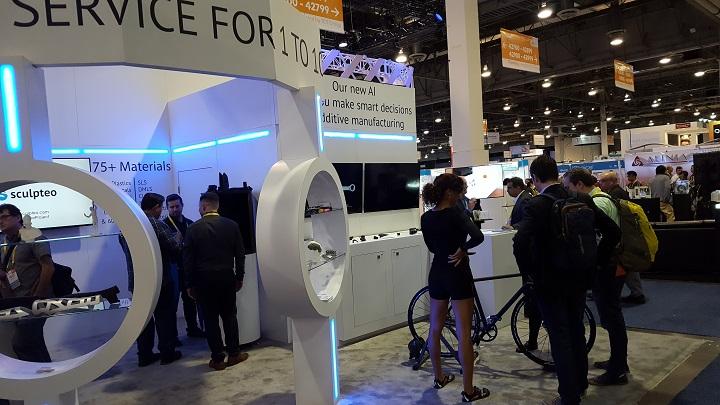 Having noted the apprehension often involved in entering the metal AM market for customers, Sculpteo sought to make this process easier for everyone involved. Customers scared off by unknowns in pricing or product, and companies frustrated by inquiries that don’t turn into orders, can both be appeased by the Agile Metal Technology approach, which seeks to smooth out the process from start to finish. Sculpteo looked at the problems surrounding entry into metal AM from several angles, and even thought about writing a book out to give full details and information — but to make every aspect more approachable, they leaned toward AI instead, choosing to “create an expert artificial intelligence system to see what is viable,” as Moreau explained.
Having noted the apprehension often involved in entering the metal AM market for customers, Sculpteo sought to make this process easier for everyone involved. Customers scared off by unknowns in pricing or product, and companies frustrated by inquiries that don’t turn into orders, can both be appeased by the Agile Metal Technology approach, which seeks to smooth out the process from start to finish. Sculpteo looked at the problems surrounding entry into metal AM from several angles, and even thought about writing a book out to give full details and information — but to make every aspect more approachable, they leaned toward AI instead, choosing to “create an expert artificial intelligence system to see what is viable,” as Moreau explained.
Moreau then demonstrated for me the first of the ultimately six modules of Agile Metal Technology to be released, the Business Case. The system asks questions to validate at every step whether a project is viable. Holding up a part already having been printed, Moreau put in approximately the dimensions and parameters of this as an example, answering the system’s queries regarding file (“Do you have a 3D file?” “What about a 2D drawing?”), preferred metal, industry of use, dimensions, volume, ideal unit cost (provided in euros, dollars, and pounds), how many units will be made and whether they are to be identical, timing preference, tolerance, objectives, function, and force to be applied — after these are all answered, the system provides available materials to choose from, providing a business case, full assessment, and good and bad news of the submission. The entire demo lasted maybe three minutes, after which we could see that the project idea was indeed viable, and the system had recommendations based on preferred timing on what metals would be the best options.
- Moreau demonstrates Agile Metal Technology
- He adds approximate parameters to recreate this part in metal
- The project is validated, with the AI offering suggestions to improve the process
“This is a learning software,” Moreau said. “It learns from each user.”
The final question is all-important for both user and service bureau alike: Based on this analysis, do you think you’ll proceed with this project? By answering questions ahead of time, this saves time and energy on the parts of both parties involved in a potential project; the customer is fully informed about what is possible within their preferred parameters, and a human working on the service end of the project only becomes involved after a validated project has been approved. The launches of the additional five modules in addition to the Business Case (Design Optimizer, Lattice Generator, Support Optimizer, Post-Processor, Batch Controller) are slated for later this year, and will come one at a time.
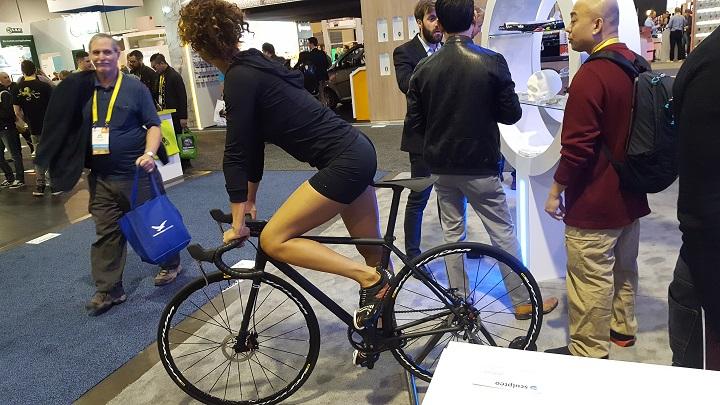 Further showing off Sculpteo’s prowess in metal AM was a physical representation in the form of a fully functional bicycle created using Sculpteo’s digital fabrication techniques — according to the company, 70% of the Digital Bike’s parts were created using the company’s platforms within a two-month span and about a $4,200 budget.
Further showing off Sculpteo’s prowess in metal AM was a physical representation in the form of a fully functional bicycle created using Sculpteo’s digital fabrication techniques — according to the company, 70% of the Digital Bike’s parts were created using the company’s platforms within a two-month span and about a $4,200 budget.
In addition to metal 3D printing technology, parts for the bicycle were created using CLIP technology, as Sculpteo turned to Carbon‘s fast 3D printing capabilities in three materials (rigid polyurethane, flexible polyurethane, and elastomeric polyurethane), as well as SLS (in carbonmide, alumide, and nylon) and DMLS (titanium) 3D printing, and laser cutting of leather, aluminum, and stainless steel. You can check out the assembly process in a video provided by Sculpteo:
On the day of Pepcom’s event, Moreau rode the bike from his hotel to the Mirage, pedaling his way to the Sculpteo booth on this show floor: “The dirt on the pedals is very real, because this bike is meant for use,” he explained. The bike is so thoroughly intended for use that, starting at the beginning of this week, its designers, Alexandre Orsetti and Piotr Widelka, began their 700+ mile trek on it from Las Vegas to San Francisco. The company is eager to show the road worthiness of the bike, clearly highlighting that this is no prototype, but is a personal vehicle ready for real world use. Sculpteo will be documenting the full ride using #SculpteoBikeProject.
While the first two days of my CES experience were the most Sculpteo-filled, I saw throughout my time on the floor at the Sands expo hall that the booth was constantly buzzing with activity. With plenty to show there, including an M1 3D printer from Carbon, 3D printed prosthetic covers for UNYQ, 3D printed implants, smoothed parts, and more, it’s no wonder that this particular booth drew a crowd.
Below are more photos from Sculpteo as seen at CES 2017:
Discuss in the Sculpteo forum at 3DPB.com.
[All photos taken at CES 2017 by Sarah Goehrke for 3DPrint.com]Subscribe to Our Email Newsletter
Stay up-to-date on all the latest news from the 3D printing industry and receive information and offers from third party vendors.
You May Also Like
Precision at the Microscale: UK Researchers Advance Medical Devices with BMF’s 3D Printing Tech
University of Nottingham researchers are using Boston Micro Fabrication‘s (BMF) 3D printing technology to develop medical devices that improve compatibility with human tissue. Funded by a UK grant, this project...
3D Printing Webinar and Event Roundup: April 21, 2024
It’s another busy week of webinars and events, starting with Hannover Messe in Germany and continuing with Metalcasting Congress, Chinaplas, TechBlick’s Innovation Festival, and more. Stratasys continues its advanced training...
3D Printing Webinar and Event Roundup: March 17, 2024
It’s another busy week of webinars and events, including SALMED 2024 and AM Forum in Berlin. Stratasys continues its in-person training and is offering two webinars, ASTM is holding a...
3D Printed Micro Antenna is 15% Smaller and 6X Lighter
Horizon Microtechnologies has achieved success in creating a high-frequency D-Band horn antenna through micro 3D printing. However, this achievement did not rely solely on 3D printing; it involved a combination...


